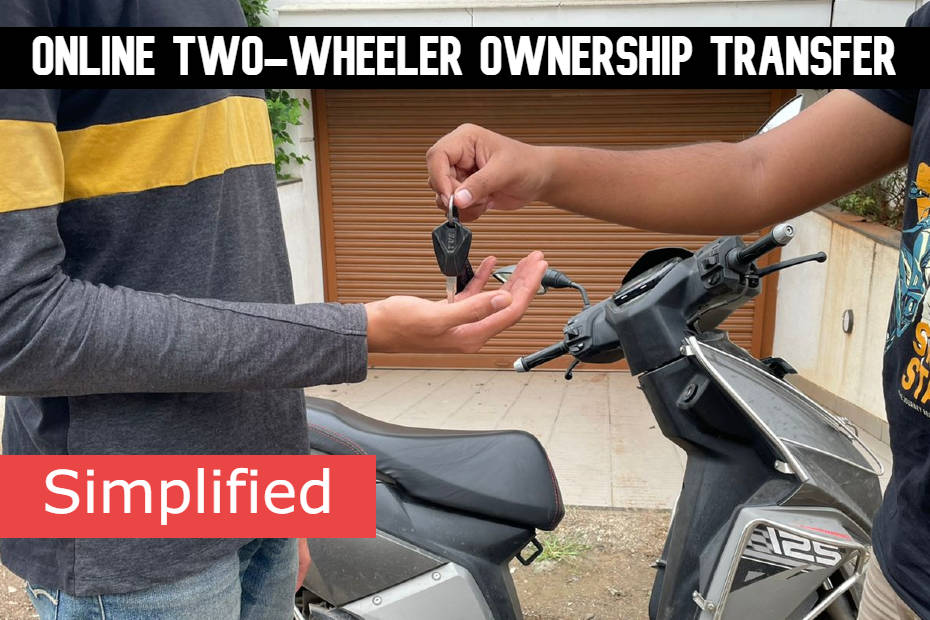How To Transfer Two-wheeler Ownership Online?
Published On Oct 13, 2022 08:55 AM By Bernard Mascarenhas
- 2456 Views
In the digital age, the process isn’t as hard as it was earlier

Earlier, we helped you with a guide on how to buy a used two-wheeler. Well, after you bring home your new (used) bike or scooter, you would wonder about the process of transferring the ownership of your new ride to your name.
Friends and acquaintances would suggest you to involve a RTO agent to get this job done, as such a task is generally regarded to be accompanied with bureaucracy and multiple visits to your local RTO. However, being in the digital age and with the government’s thorough initiative of moving most of its services online, this process has become a lot easier.

So here’s a guide on how to transfer the ownership of a two-wheeler online. That said, we aren’t being comprehensive in describing this process, so you will have to use a bit of your own judgement while on the mentioned websites. Also, the process might slightly vary from State to State.
Before we dive into the process, here’s a list of documents you would require:
-
-
Registration certificate - Original registration certificate (RC) held by the seller. The RC may also be a smart card.
-
Address proof documents - Latest utility bill (electricity, telephone, water, gas, etc.), any KYC document with the permanent address, etc.
-
Insurance copy - Valid insurance certificate of the vehicle.
-
PAN Card - PAN of both the seller and buyer.
-
PUC Certificate - Valid Pollution under Control certificate.
-
Form 28 - Application and grant of ‘No Objection Certificate’. Form 28 is necessary to avail of a ‘No Objection Certificate’ from your local RTO before selling the vehicle. It is only mandatory during an interstate transfer of ownership.
-
Form 29 - Notice of transfer of ownership of a motor vehicle.
-
Form 30 - Application for intimation and transfer of ownership of a motor vehicle.
-
Form 31 - Application for transfer of ownership in the name of the person succeeding to the possession of the vehicle.
-
Form 35 - Notice of termination of an agreement of hire-purchase/lease/hypothecation. Form 35 is only necessary if the vehicle is currently hypothecated to a bank.
-
Go to the Parivahan website

Here, choose “Online Services” in the top menu bar and then in the dropdown menu that appears, choose “Vehicle Related Services”.
Select your State

On the page that appears after completing the previous step, choose your State. Here it is important to understand that some States will allow you to complete the entire transfer of ownership process online, while others would still need you to visit your local RTO to complete the process.
Enter vehicle registration number

On your State website, enter the two-wheeler’s registration number and click on ‘proceed’. In the page that opens, you have to choose the option that says “Transfer of Ownership.” Depending on your State website, it might either be listed under the online services menu, or be visible up front.
Enter chassis number
In the form that follows, you’ll be asked to enter the last five digits of the two-wheeler’s chassis number, along with your phone number. Upon clicking ‘Generate OTP’, you’ll receive an OTP on your mobile, which you then must enter on the website. However, if the mobile number hasn’t been attached to your vehicle’s registration, that’s something you’ll need to do first using the Parivahan website.
Select applications
After the OTP is entered, click on the “Show details” option on the subsequent page. You’ll then be shown a list of applications, and you’ll need to select the appropriate one. You’ll now need to enter your details as well as the details of the previous owner. You might even need to upload some documents that have been mentioned at the beginning of this article.
Make payment
After completing the above step, you’ll have the option to pay the ownership transfer fee by making an online payment using your credit/debit card, net banking or UPI. Once you’ve made the payment, you can download and print the receipt.
- This Modified KTM 200 Duke Scrambler Can Even Carry Your Surfing Board!
- Upcoming Bikes in India
- Upcoming Scooters in India
Further process
After you’ve completed the online process, you may still need to go to your local RTO to complete the full formalities along with the receipt of the payment, depending, of course, on the rules prevailing in your State. However, as the majority of the work has been completed online, the RTO visit is bound to be straightforward.
Again, the above-mentioned process is bound to vary from State to State. However, the basic overview remains the same. The above steps are more or less general guidelines on how to go about the online process. You’ll still need to check with your local RTO website for the exact details.
